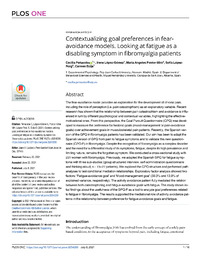Título :
Contextualizing goal preferences in fear-avoidance models. Looking at fatigue as a disabling symptom in fibromyalgia patients |
Autor :
Peñacoba, Cecilia 
López-Gómez, Irene 
Pastor-Mira, María Ángeles 
López Roig, Sofía 
ECIJA-GALLARDO, Carmen  |
Editor :
Public Library of Science |
Departamento:
Departamentos de la UMH::Ciencias del Comportamiento y salud |
Fecha de publicación:
2021-07-08 |
URI :
https://hdl.handle.net/11000/33514 |
Resumen :
The fear-avoidance model provides an explanation for the development of chronic pain, including the role of perception (i.e. pain catastrophism) as an explanatory variable. Recent research has shown that the relationship between pain catastrophism and avoidance is influenced in turn by different psychological and contextual variables, highlighting the affective-motivational ones. From this perspective, the Goal Pursuit Questionnaire (GPQ) was developed to measure the preference for hedonic goals (mood-management or pain-avoidance goals) over achievement goals in musculoskeletal pain patients. Recently, the Spanish version of the GPQ in fibromyalgia patients has been validated. Our aim has been to adapt the Spanish version of GPQ from pain to fatigue symptoms and to validate this new questionnaire (GPQ-F) in fibromyalgia. Despite the recognition of fibromyalgia as a complex disorder and the need for a differential study of its symptoms, fatigue, despite its high prevalence and limiting nature, remains the forgotten symptom. We conducted a cross-sectional study with 231 women with fibromyalgia. Previously, we adapted the Spanish GPQ for fatigue symptoms with three sub-studies (group structured interview, self-administration questionnaire and thinking-aloud; n = 15–27 patients). We explored the GPQ structure and performed path analyses to test conditional mediation relationships. Exploratory factor analysis showed two factors: ‘Fatigue-avoidance goal’ and ‘Mood-management goal’ (39.3% and 13.9% of explained variance, respectively). The activity avoidance pattern fully mediated the relation between both catastrophizing and fatigue-avoidance goals with fatigue. The study shows initial findings about the usefulness of the GPQ-F as a tool to analyze goal preferences related to fatigue in fibromyalgia. The results supported the mediational role of activity avoidance patterns in the relationship between preference for fatigue-avoidance goals and fatigue.
|
Área de conocimiento :
CDU: Filosofía y psicología: Psicología |
Tipo de documento :
info:eu-repo/semantics/article |
Derechos de acceso:
info:eu-repo/semantics/openAccess
Attribution-NonCommercial-NoDerivatives 4.0 Internacional |
DOI :
https://doi.org/10.1371/journal.pone.0254200 |
Publicado en:
PLoS ONE, July 8, 2021 |
Aparece en las colecciones:
Artículos Ciencias del Comportamiento y Salud
|

 La licencia se describe como: Atribución-NonComercial-NoDerivada 4.0 Internacional.
La licencia se describe como: Atribución-NonComercial-NoDerivada 4.0 Internacional.
.png)